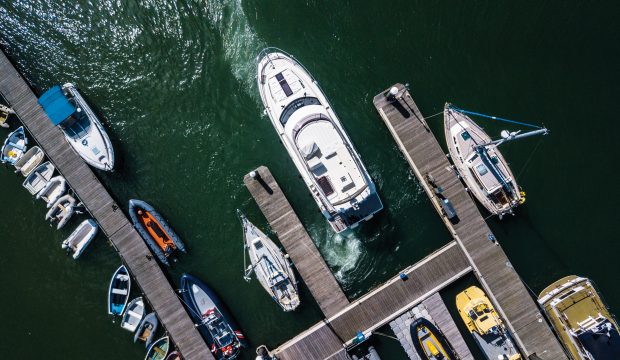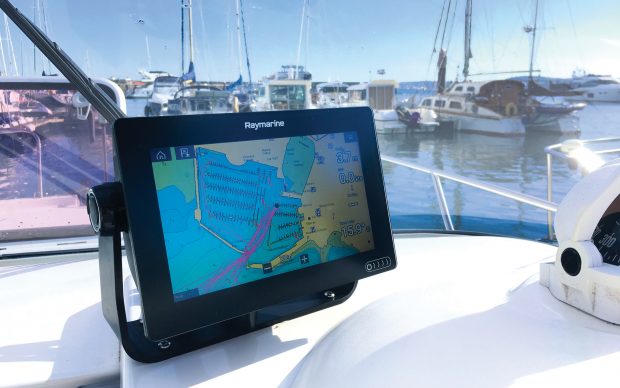Raymarine has developed two new pieces of technology that could change the way we navigate
Never before have leisure boat owners had access to such a sophisticated array of navigational electronics. The leading manufacturers are on a never-ending mission to make navigating on the water safer, more intuitive and more inventive.
Thermal imaging and the use of tablets, smartphones and even smart watches to control your boats’ system are just a few of the recent introductions. And the drive to innovate continues with Raymarine launching two new pieces of technology that have the potential to alter the way we navigate entirely.
The first and most significant is its ClearCruise Augmented Reality (AR) technology for the Axiom range of multi-function displays (MFD). The system works by combining at least one Raymarine camera (either the CAM210 Bullet or CAM220 Eyeball), an AR200 video stabilisation unit and an Axiom MFD on which to overlay information.
The ClearCruise software is a free download but you will need to fork out at least £1,195 inc VAT for the CAM220 or £1,395 for the more compact CAM210, and £525 for the AR200 stabilisation module.

ClearCruise highlights dangerous targets in red
The AR200 stabiliser is key as it is this that ensures the image presented on the MFD is stabilised, steady and clear. It also contains a high speed GPS receiver and 9-axis attitude and heading reference system. The camera(s) can be mounted anywhere that has an unrestricted view forward or aft.
Once configured, the camera’s field of view is fed to the MFD but with AIS targets, waypoints and charted objects overlaid on the display in real time.
A colour coding system is applied to AIS targets so that vessels which present a potential collision risk have their target information highlighted in red. Tap the AIS target box and the vessel’s name, heading and speed is displayed.
It’s the same story with charted objects, so when a buoy comes into view, its name, position and flashing sequence are displayed. Three icons at the bottom of the screen allow you to de-clutter the view by selecting only the information that you wish to see, so you could remove AIS targets and just have your waypoint and charted objects, for example.
Solent trials
We trialled ClearCruise aboard Raymarine’s purpose built Hardy 42 test vessel Raymariner in the Solent, an ideal location given the amount of traffic and navigation marks.
The highest compliment I can give the technology is that it feels perfectly natural to use and interact with. There is very little to learn in order to get the best out of it and it immediately feels familiar.

Raymarine DockSense: Virtual fender makes this boat uncrashable

Control your boat from afar: Besenzoni remote control app
Everything from your banking to your home lighting and heating can be controlled via an app on your phone these
Increasing the range can lead to a cluttered screen, so in a busy area like the Solent it’s best to set it to a range of a few miles so you can easily identify vessels and objects in the vicinity.
Issues can arise when one craft crosses behind another, causing vessel information to overlap, but it’s only temporary and doesn’t detract from what is a particularly helpful new navigation aid.

Using AR alongside the chart screen is very effective
Though the software is compatible with any size of Axiom MFD it’s especially impressive on the larger Pro models and XL screens (as fitted to Raymariner). It’s unlikely that you will want to navigate solely on AR mode, so using a split screen set up alongside the normal chart view either on one large screen, or better still, two separate MFDs, is the way to go.
The system is brilliantly integrated with the latest version of Raymarine’s slick operating system, LightHouse 3.7, and with FLIR night vision support and the integration of MARPA-tracked targets already in the pipeline, the functionality of ClearCruise is only going to improve.
Drone wars
A blast across the Solent to a deserted Osborne Bay provided an ideal opportunity to demo Raymarine’s second piece of new technology – UAV (Unmanned Aerial Vehicle) integration for Axiom MFDs. UAVs, or drones as they are more commonly known, are becoming popular with leisure boaters who want aerial photos and videos of their own boat.
By integrating the aerial imaging capability of a drone into its MFDs, Raymarine is moving the game on and including functionality that is genuinely useful for boaters. Like ClearCruise, Axiom UAV is a free, downloadable update, but you do need to have a compatible DJI Mavic Pro drone.

The drone prepares for take-off aboard Raymariner
The sportsfishing community has already shown a lot of interest in this development as the ‘Virtual Tuna Tower’ allows fishermen to scout for fish from a vantage point directly above the boat, or up to 13km away. Once they’ve hooked a fish they can film themselves reeling in their catch without having to control the drone manually. The broader appeal, however, is for navigation in unfamiliar waters, for example, sending the drone into an inlet to check for obstacles before taking the boat in.
Technically, the drone can be launched and retrieved via controls displayed on the boat’s MFD but the demo team on our trial preferred using the drone’s handset for these intricate manouevres before switching to the Axiom controls once airborne. The display splits itself between the view from the drone’s camera and a chart showing the location of the drone relative to the boat.
For scouting purposes you can send the drone to a waypoint via a ‘go to’ option where it will hover and wait for the boat to catch up. The drone’s GPS is constantly updating its position and sending that information to the boat, so if you hit the ‘return to boat’ function the drone will return to the boat and not the take-off position.

The drone’s speed and distance are displayed on the Axiom screen, as are the record and photo buttons
Currently there isn’t a function that allows the drone to track in front of the mothership to scan the path ahead on the move but it might make a useful addition for the future.
The presentation of the drone’s controls and flight status are cleanly integrated into the Axiom interface through LightHouse 3.7, and the user can see the drone speed, distance and height as well as battery life and remaining flight time. Two virtual buttons control the drone itself and a slider adjusts the up and down pan of the gimballed camera.
Buttons in the top left of the screen allow the user to take still snapshots or start/stop recording at any time, and the ‘circle me’ function instructs the drone to circle the boat for hands-free tracking.
Our short demo gave only a brief insight into how this technology could be employed by leisure boaters but with drone ownership on the rise amongst boat owners, Raymarine is firmly ahead of the curve here. Combined with the ClearCruise technology, it’s a very appealing package. Whichever way you look at it, we’ve come a long way since the sextant.










